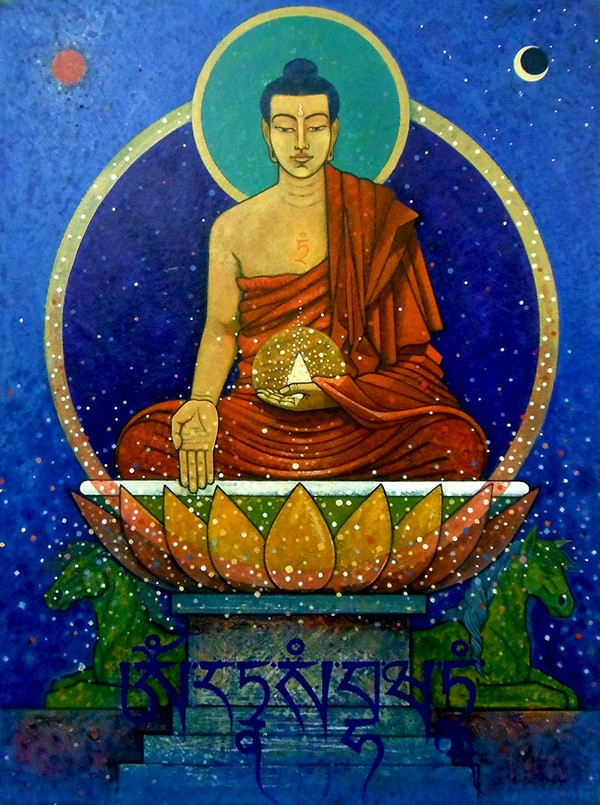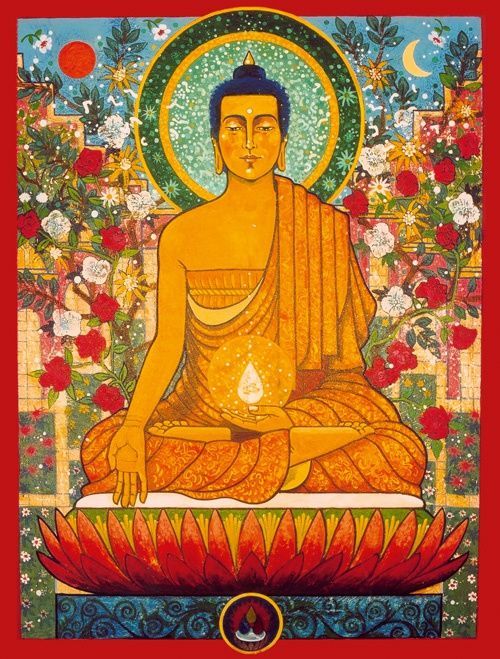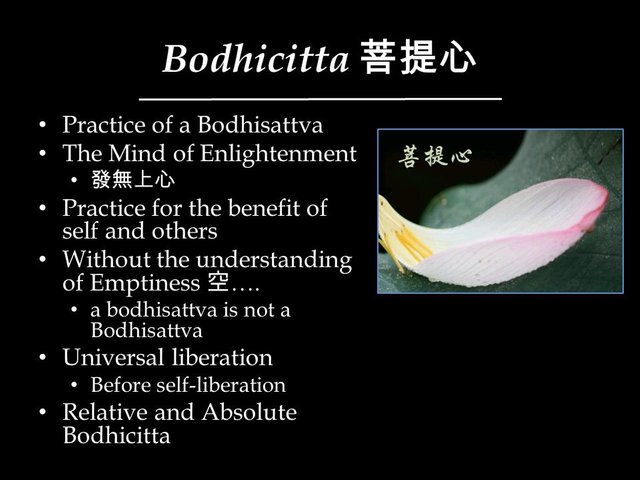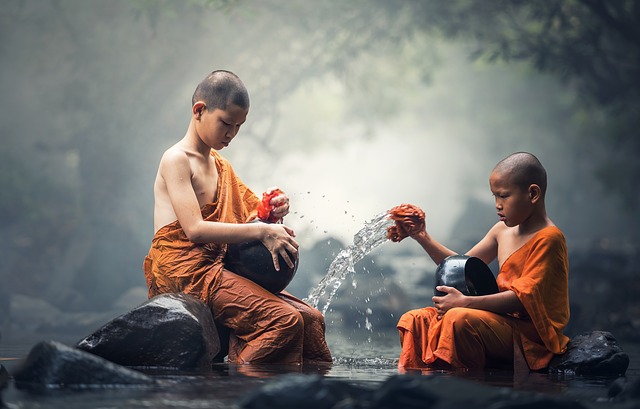Buddhist Psychology Part 4: Transform Yourself With Buddha RATNASAMBHAVA - Gold Buddha of the South - Generosity

Every human being has the potential to realize their Buddha nature. But sometimes it is not so easy when dealing with others we have negative states arise if we feel we have been treated unfairly. With some dedication, commitment and quality instruction through practice and study one is able to with absolute certainty realize the true nature of mind. We have the same heart and mind that Shakyamuni Buddha did so we can also realize our Buddha nature.
The Five Buddha Families gives us an excellent and complete framework to work with our hearts and minds as we meditate. Today we will look at another Buddha in the five families: RATNASAMBHAVA.

Let’s review the whole list of the Five Buddha Families first:
• Buddha Family – VAIROCHANA - “Consciousness” - Center - White – All accommodating - Teaching the Dharma - Uses the means of Turning the Wheel of Dharma to remove the maladaptation to stress that manifests as ignorance – Wisdom of essence of the dharma.
• Karma Family – AMOGHASIDDHI - “Intention” - North – Green - Mental formation, concept - Fearlessness - Uses the means of protection and destruction to remove the maladaptation to stress that manifests as envy and jealousy - Wisdom of perfect practice.
• Vajra Family – AKSHOBYA - “Form” – East – Blue – Non-dualist, humility – Uses the means of Pacification to remove the maladaptation to stress that manifests as aggression – Wisdom of reflection.
• Ratna Family – RATNASAMBHAVA - “Feelings” – South - Gold/Yellow – Equanimous, giving – Uses the means of enrichment to remove the maladaptation to stress that manifests as increasing, pride, and greed – Wisdom of equanimity.
• Padma Family – AMITABHA - “Perceptions” - West – Red – Inquisitive, meditation – Uses the means of magnetizing to remove the maladaptation to stress that manifests as subjugation, selfishness – Wisdom of observation.
The Imagery of RATNASAMBHAVA
Ratnasaṃbhava, as we can see from the chart above, is associated with the skandha of feeling and its relationship to consciousness. His actions are centered around promoting Buddhism and cultivating inspiration to increase knowledge of Dharma. His name can be translated as “born from the jewel” or "Origin of Jewels"and jewel corresponds with his family, Ratna. His hand holds the the mudra of supreme giving which is called the varada mudra.

In artwork Ratnasambhava is gold/yellow in color, like a midday sun, and his wisdom is of equality which knows that everything has the same nature which is the nature of Emptiness. Seated in full lotus posture on a white moon disc which is the centre of a yellow lotus. His right hand is resting on his right knee with the open hand facing outwards in the giving mudra. His left hand is resting in his lap with the palm facing upwards and on the open palm Ratnasambhava holds a shining jewel called a cintamani which is a symbol of Bodhichitta which is the highest value in Buddhism.
Focusing on Ratnasambhava's imagery in the form of mandalas and mantras develops equanimity and equality while removing inner feelings of pride. Prosperity is the quality infuses the aspirants consciousness asserting that one need not build up feelings of pride to sustain any illusions that anything needs protection because nothing can truly be taken away since everything is impermanent and all is emptiness as is the fundamental truth of reality.
I think it is absolutely essential for us to have loving kindness towards others. There is no doubt about this. Loving kindness is the essence of bodhicitta, the attitude of the bodhisattva.
Without bodhicitta, nothing works. And most of all, your meditation doesn't work, and realizations don't come.
~Lama Thubten Yeshe
Kopan Monastery, Nepal

Bodichitta
Bodichitta is the welling up of pure compassion and desire to assist others to end their suffering and achieve enlightenment. In our practice everything is bodichitta and we start with the Absolute Bodichitta which is that we make sure all our actions are grounded in lovingkindness because ultimately everything in reality arises from emptiness and that is the view we begin with. This removes any possibility of their being self-serving or overbearing in our attitudes towards serving and relating to others.
So, rather than protecting against perceived threats the meditator can aspire to be a Bodhisattva instead and turn their efforts to developing bodhichitta. In the case of RATNASAMBHAVA this wish manifests in richness, wealth, beauty and art to be shared by all. You can probably see how elegantly this can work by changing your focus from trying to change people to putting in effort to create beauty to bathe others in this energy so their path to higher consciousness and awakening can be beautiful. This is essentially generating grace and serving from that.
Our attempts at virtue can become heavy-handed and distorted. We can go so far as to use the activity of kindness as a method of self-aggrandizement in the disguise of helping others. Even when our attempts at kindness are not distorted, trying to do the right thing can be wearing. It is a struggle. ~Atisha’s 59 Lojong Slogans with Acharya Judy Lief. Point Three: Transformation of Bad Circumstances into the Path of Enlightenment
What we need to realize is that just meditating for ourselves to stop our own suffering is missing the mark entirely. It is the illusion that we have a separate self that causing our suffering to begin with so how is selfishly just trying to end our own suffering going to work? The answer is it won’t. What will happen is that you will temporarily feel better but the “issues” you have with other people will keep coming up until you realize that we are not separate from each other and our liberation depends on assisting one another and breaking through the illusion that we are separate.
Bodhicitta is a spontaneous wish to attain enlightenment motivated by great compassion for all sentient beings, accompanied by a falling away of the attachment to the illusion of an inherently existing self.
*Bodhicitta - Wikipedia
https://en.wikipedia.org/wiki/Bodhicitta
RATNASAMBHAVA gives us an exquisite way to accomplish this. Instead of focusing on what others are doing wrong we can purify our minds by generating lovingkindness and we can do this by making a commitment to perform our actions in the spirit of generosity with the intention of increasing the Dharma. Generosity is the wish to freely give without conditions attached. So, if you perform a service or fill a need you do it with your whole heart and allow it to be received in whichever way it is received. You drop the expectation that people are going to do things the way you think they should because of certain conditions you think have been established. This does not mean we stay in an unsafe environment or that we don’t set healthy boundaries. We do that but we do that in the spirit of lovingkindess and that is true generosity.
Once we have committed to this intention it frees up our minds to create beauty. The power of this cannot be overstated. To be able to be the master of our emotions and create beauty regardless of circumstances will be noticed because this is the secret desire with every human being’s heart – to end their suffering and live in equanimity, grace and beauty. No one wants to suffer and everyone wants to live well! If we keep this one truth in our hearts, we can focus on living artfully with kindness and that can be a very strong factor in arising interest investigating the Dharma. Create a life of beauty and share it – that is what we all want.
For me, it has been creating beautiful music, being on a path of healing and writing about my journey to inspire others and volunteering my time be a support to marginalized people who are suffering. But, none of that matters if I am not transforming myself daily by committing to practicing the paramitas (perfections) in my heart every day. As a Buddhist it is my responsibility to conduct myself in alignment with the Noble Eightfold path and cultivate the paramitas. From that springs grace. It’s that simple.

Eight Verses of Training the Mind
by Geshe Langri Thangpa
By thinking of all sentient beings
As more precious than a wish-fulfilling jewel
For accomplishing the highest aim,
I will always hold them dear.
Whenever I’m in the company of others,
I will regard myself as the lowest among all,
And from the depths of my heart
Cherish others as supreme.
In my every action, I will watch my mind,
And the moment destructive emotions arise,
I will confront them strongly and avert them,
Since they will hurt both me and others.
Whenever I see ill-natured beings,
Or those overwhelmed by heavy misdeeds or suffering,
I will cherish them as something rare,
As though I’d found a priceless treasure.
Whenever someone out of envy
Does me wrong by attacking or belittling me,
I will take defeat upon myself,
And give the victory to others.
Even when someone I have helped,
Or in whom I have placed great hopes
Mistreats me very unjustly,
I will view that person as a true spiritual teacher.
In brief, directly or indirectly,
I will offer help and happiness to all my mothers,
And secretly take upon myself
All their hurt and suffering.
I will learn to keep all these practices
Untainted by thoughts of the eight worldly concerns.
May I recognize all things as like illusions,
And, without attachment, gain freedom from bondage.
What do you think?

@soulsistashakti is a musical artist and writer based in NYC as well as a practitioner of Buddhist teachings. You can check out my music on my FB artist page at https://www.facebook.com/soulsistashakti
Check out my blog for other essays on Buddhism and meditation
Recent posts
Transform Your Life With the Five Buddha Families - Part 3- AKSHOBYA – THE DEEP BLUE BUDDHA "Immovable One"
THE FIVE BUDDHA FAMILIES PART 2 - Green Buddha of the North - AMOGHASIDDHI – Fearless Energy and Action
Buddhist Psychology: What Are the Five Buddha Families?
Awaken Your Creativity/Writing With Morning Pages and Buddhist Mindfulness Practices
My First 10 Day Buddhist Samatha-Vipassana Meditation Retreat in NYC
Another great post. Thanks. Motivates me to do be more diligent in my practices and meditations. Don't know, now, which one I like the best. all of them I suppose.
This one is the one that was most important for me to get, but all five lords/buddhas are aspects of Buddhahood so they are all equally important :) Fifth and final one coming Monday.
Have a great weekend!
Looking forward to it. Blessings.